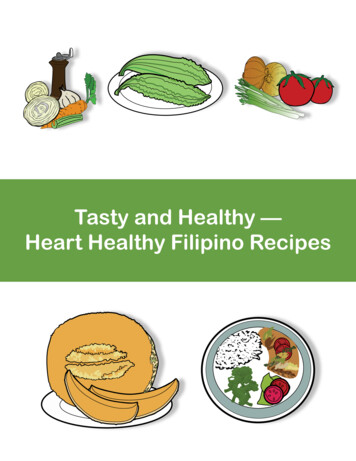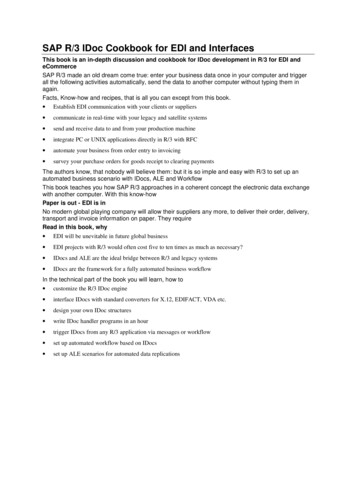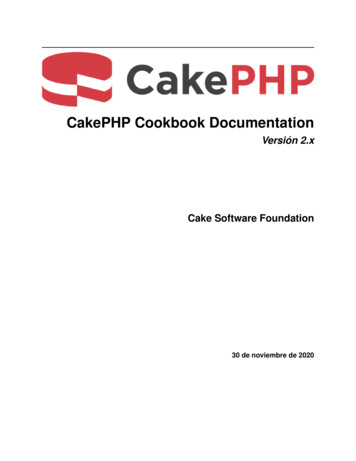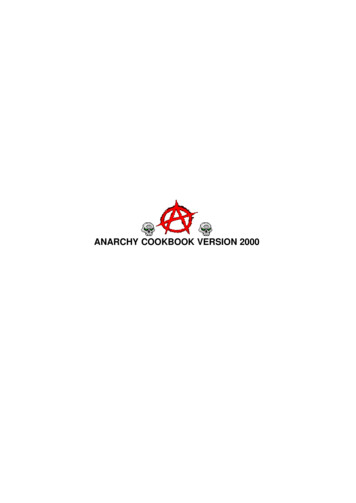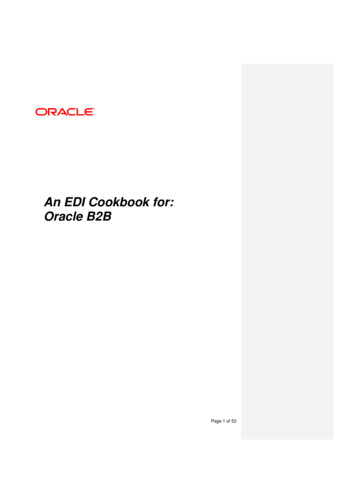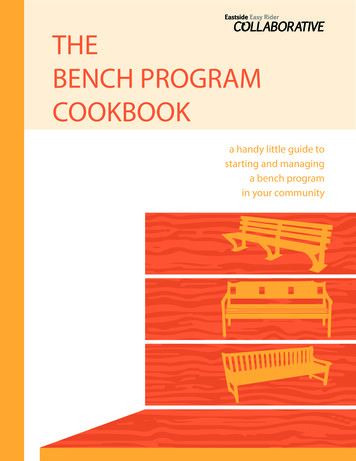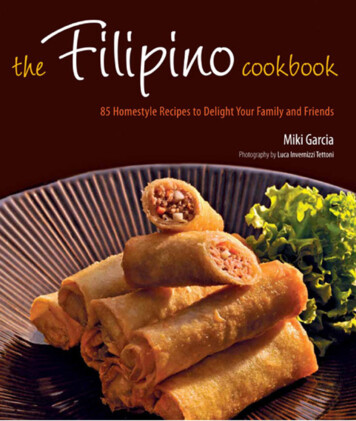
Transcription
Filipino cookbookthe85 Homestyle Recipes to Delight Your Family and FriendsMiki GarciaPhotos byStyling byLuca Invernizzi TettoniTheo Domini O. ZaragozaT u t t le PublishingTokyo Rutland, Vermont Singapore
contentsAsia’s Best-kept Culinary Secret 7Essential Filipino Ingredients 12Cooking Utensils and Techniques 1820Basic RecipesGarlic Mayonnaise Dip 20Vinegar Garlic Sauce 20Sweet and Spicy Sauce 21Pickled Green Papaya 21Vinegar and Sautéed Shrimp Paste Sauce 21Sweet Garlic Sauce 21Sweet and Sour Sauce 21Spicy Garlic Vinegar Dipping Sauce 22Tomato and Salted Egg Salad 22Salted Eggs 22Crispy Fried Garlic 23Liver Paste 23Perfect Steamed Rice 2324Chapter 1Appetizers and SnacksFried Shrimp with Assorted Dips 26Crunchy Fried Squid 27Chicken Tamales 28Chicken Empanadas 29Pan de Sal Bread Rolls 30Spring Rolls 31Fresh Pork Salad Rolls 32Crispy Fried Fishballs 33Papaya Shrimp Fritters 3334Chapter 2SoupsFish Soup with Miso Dip 36Wonton Soup 37Sinigang Shrimp Soup 39Macaroni Soup 39Noodle Soup with All the Trimmings 40Quick Eggdrop Chicken Noodle Soup 41Chicken Soup with Green Papaya 42Pork and Corn Soup 43Pork Soup with Squash 43
44Chapter 3Meat DishesRoasted Marinated Pork 46Sweet Soy Pork with Black Beans 47Crispy Lechon Pork 48Glazed Christmas Ham with Pineapple 49Fiery Pork Stew with Coconut 49Traditional Tocino Bacon 50Pork and Tomato Stew 51Filipino Beef Steak 53Kaldereta Beef Stew 53Marinated Morcon Stuffed Beef Roll 55Oxtail Vegetable Stew 56Stuffed Meatloaf with Cheese and Sausage 5758Chapter 5Seafood DishesSautéed Squid 70Sautéed Marinated Clams 71Fried Whole Fish with Eggs 73Sautéed Shrimp with Long Beans 73Fried Marinated Fish 74Sweet and Sour Fish 75Piquant Fish Stew 75Stuffed Crabs 76Filipino Ceviche 77Chapter 6VegetablesPinakbet (Mixed Vegetables with Anchovy Sauce) 80Mung Bean and Spinach Stew 81Braised Chayote with Shrimp 81Banana Blossom with Shrimp 82Stuffed Eggplant 83Sautéed Corn with Shrimp 84Filipino Spinach and Egg Salad 8586Chapter 7Rice and Noodle DishesCuban Rice with Ground Beef 88Kapampangan Paella 89Filipino–Style Seafood Paella 90Fried Rice with Egg 91Rice Porridge with Chicken 92Fried Rice Noodles 93Noodles with Shrimp and Tofu 94Sautéed Bean Thread Noodles 95Chapter 4Poultry DishesChicken and Vegetables in Tangy Tomato Sauce 60Barbecued Chicken Skewers 61Coconut Chicken with Pineapple 62Tangy Asado Chicken 63Chicken Adobo 64Filipino Fried Chicken 65Chicken Stew with Vegetables 66Classic Filipino Chicken Pot Pie 67687896Chapter 8Desserts and BeveragesSweet Coconut Milk Delight 98Champorado (Chocolate Rice Porridge) 98Sweet Purple Yam Pudding 99Sweet Rice Cakes with Fried Coconut Topping 100Pulburon (Toasted Butter Cookies) 100Egg Yolk Treats 101Sweet Banana and Jackfruit Rolls 102Bibingka (Coconut Sponge Cakes) 103Halo-halo (Mixed Fruits and Shaved Ice Parfait) 104Filipino Hot Chocolate 105Rice Cakes with Sweet Coconut Filling 105Iced Tapioca Pearl and Jelly Drink 106Sweet Mango Juice 107Tangy Green Mango Juice 107Healthy Ginger Tea 107Filipino Leche Flan 108Index 110Resource Guide 112
Roasted Marinated Pork (page 46)6the filipino cookbook
Filipino Cooking:Asia’s Best-kept Culinary SecretMy adventure with Filipino cooking began when I lived in Manilaand in rural Iba (in Zambales Province) for about a year in the1990s. I had always loved the country and the people of thesetropical islands; however, it was only after living there forseveral years that I discovered and grew to love the amazingvariety of foods that the Philippines has to offer. When I metand later married my Filipino husband, my love of the cuisinewas further strengthened since he was from the provinceof Pampanga in Central Luzon, which is considered by mostFilipinos to have some of the best cooking in the nation.Kapampangans—as the people from Pampanga are calledin Filipino—are skilled cooks and spend a great deal of theirtime preparing fine dishes and sharing sumptuous meals withrelatives and friends. When not cooking, the Kapampangansare generally thinking about what to prepare for their nextmeal. This great passion for food and attention to detail meansthat my husband loves to spend time in the kitchen, and evenwhen I am cooking he likes to interrupt me and often offers totake over, especially if he feels I’m not doing things correctlythe “Kapampangan way.” Due to this, I can truly say that hisKapampangan food culture has thoroughly rubbed off on meover the years.Even though we have lived in many other countries of Asiaand Europe and now live in America, I prefer to cook Filipinodishes whenever we entertain because I find that everybodyloves the food. Over the years I have scribbled enough recipesto fill up several notebooks. For many years, I tried to find acookbook of Kapampangan and other regional Filipino recipesthat would satisfy the discriminating tastes of our Filipinofriends and relatives, but I could never find one. I ended upasking my foodie friends and relatives for their favorite recipes,trying them out whenever I could, and, through trial and error,compiling a large collection of recipes that seem to exemplifythe best dishes and flavors from all parts of the archipelago.Thus, this cookbook, the result of that effort, reflects the verybest of Filipino cooking, and the recipes encompass a largeselection of traditional and authentic dishes that can be enjoyedby anyone on any occasion and are accessible to Filipinos andnon-Filipinos alike.Filipino cuisine is one of the best-kept culinary secrets inAsia. Unlike Japanese, Chinese or Thai food, its dishes are notreadily available in restaurants. Filipinos love to entertain inlarge groups and have a tradition of throwing large and loudparties at home. And so it is only in Filipino homes—whereverthey are around the world—that can one find truly authenticFilipino cuisine.Like other cuisines, Filipino cooking reveals a great dealabout the history and geography of the place from which itsprang and the people who created it. The dishes were notdeveloped in the kitchens of royal palaces or by wealthyaristocrats, and nor is there a long tradition of dining out inrestaurants. The food is instead the creation of the common folk.In short, Filipino cuisine is the everyday “people’s food.” Itsdishes are prepared to be enjoyed by everyone whenever thereis a reason or occasion to gather and celebrate. Filipinos viewfood primarily as a means of connecting with family and friendsrather than an end in itself.One of the things I love about Filipino cuisine is its simplicity.By and large, the dishes do not require any special utensils,there are no complicated techniques, and it does not use manyexotic or expensive ingredients. Most of all, preparation timesare short since it’s often too hot and humid in the Philippines tospend very much time in the kitchen!The ingredients required to make Filipino dishes are, for themost part, very easy to find. Expatriate Filipino communities,and markets catering to their needs, have sprung up in manyurban areas around the world. In addition, a large numberof Filipino ingredients originally came from the New World(brought over by the Spanish from Mexico) and can now befound in most large and well-stocked supermarkets (see pages12–17 for a list of Essential Filipino Ingredients).The Filipino national cuisine is an amalgamation of manydifferent regional styles from the various islands as wellas many historical influences from abroad. The Filipinosthemselves describe their cuisine as sari-sari (varied) and halohalo (mixed) because of the wide array of influences found evenwithin a single meal. Filipino cooking can truly be considereda melting pot, deeply influenced by over 100 different islandethnic groups as well as by settlers from all parts of Asia, and bythe Spanish and American colonizers.The native inhabitants of the islands are known as Aetas,who still live in the mountains of Luzon and Mindanao. Theyare believed to share the same ancestry as the aboriginalsof Australia and the Papuans of New Guinea. The arrival ofthe Malayo-Polynesian peoples from the Asian mainland viaTaiwan 6,000 years ago drove them into the mountains, andintroduction7
Malayo-Polynesians are now the predominant inhabitants ofthe Philippines. Their cooking styles involve the preparation offoods by boiling, roasting and steaming using coconut milk andpeanut oil. The roasting of a whole pig, known as Lechon, isbelieved to be an ancient Polynesian practice.Regular contacts with the Chinese also influenced Filipinocuisine. Chinese traders, who visited and settled on the islandsfrom the fifth century onward, brought their culinary techniquesand ingredients. Fried Rice Noodles (page 93) and SpringRolls (page 31) are two typical Filipino dishes with their rootsin China. Many of the typical Filipino sawsawan, or dippingsauces, are also of Chinese origin. Prior to the arrival of theSpanish, the islands were also visited by Arab, Japanese, Thai,Vietnamese, Javanese, Cambodian, Indian and Portuguesetraders. Each of these cultures subtly influenced the evolution ofthe local cuisine.The Spanish colonization of the Philippines in the sixteenthcentury lasted for 300 years and brought significant SpanishSautéed Squid (page 70)8the filipino cookbookand Mexican influence, via Spain’s colonization of that country,to the food culture of the islands. Located on the vital sea routesof Asia, the Philippines became a lucrative trading port forthe Spanish. In exchange for sugar and other local products,the Spanish brought chili peppers, tomatoes, corn, cacao andpotatoes from the New World. It is said that as many as 80percent of local Filipino dishes have some Spanish or Mexicaninfluence, either because of their ingredients or because theyare local adaptations of original Spanish or Mexican dishes.Many Chinese dishes that were introduced during theSpanish colonial times were given Spanish names. Forexample, the ever-popular Chinese rice congee was giventhe name Arroz Caldo (Rice Porridge with Chicken, page 92),while Chinese-style fried rice was called Morisqueta Tostada—commonly known by its Tagalog name, Sinangag (Fried Ricewith Egg, page 91). Spanish food and culture, and the Catholicreligion, continue to define the modern-day Philippines eventhough Spanish colonial rule ended in 1898.
Following the Spanish-American War, these islands fellunder the spell of American culture during a time of rapidmodernization. American-made canned foods becamewidely available and people used them to create new dishes.Canned meats and sausages became popular staplesas did canned fruit cocktails and condensed milk. KarneNorte, for example, is a popular dish consisting of cannedcorned beef sautéed with garlic and onions, and Halo-Halois a delicious dessert of shaved ice with sweet syrups andcanned evaporated milk. The Philippine-American experiencegave the Filipinos many new ways of turning foreign foodinfluences into something delicious and uniquely Filipino.Regional Cooking StylesIn addition to these foreign influences, the geography ofthe Philippines has also contributed to the diversity of itscuisine. As an archipelago comprising of 7,107 islands andseventeen regions, 120 different ethnic groups and 170different languages, the formation of regional cooking stylesis inevitable. Regional traditions, preferences, and availableingredients can transform a dish into something entirelydifferent as one travels from one end of the archipelago to theother. To give you a sense of the richness of Filipino diversityin its cuisine, this book includes the best recipes from thesevarious regions—from the rugged north shores of the Ilocosregion to the southern island of Mindanao.On the northwest coast of Luzon, between the mountainsand the sea, is the Ilocos region. Here, the land is rugged anddry. In this harsh climate, the Ilocano people survive by beingfrugal and hardworking. Ilocano meals include an abundance ofvegetables with some type of meat as the main feature of themeal. Ilocanos prepare their vegetables by steaming or boilingthem with a dash of sautéed fermented shrimp paste. Redmeat dishes are not commonly found, but freshwater fish arefeatured prominently. Their signature vegetable dish, Pinakbet(Mixed Vegetables with Anchovy Sauce, page 80), includesplenty of locally grown vegetables like bitter gourd, okra, andeggplant served with a tasty anchovy sauce.Pampanga has a well-earned reputation as the home to themost creative and refined cuisines found in the Philippines.Located in the central part of Luzon just east of Manila,Pampanga’s fertile soils and fish-filled rivers give the regionthe necessary ingredients to build its well-deserved reputation.Spanish chefs provided the Kapampangans with just enoughguidance on European cooking techniques to enable them tocreate their own unique and delectable native dishes. Soonthese dishes would outshine their European equivalents onthe tables of Spanish royalty (it was the Kapampangans whoprepared the meal at the proclamation of the first PhilippineRepublic). Among the original Kapampangan recipes featuredin this book are Kaldereta Beef Stew (page 53), Oxtail VegetableStew (page 56), Traditional Tocino Bacon (page 50), ChickenTamales (page 28), Kapampangan Paella (page 89), andFilipino Leche Flan (page 108).The Bicol region is located at the southern tail of theLuzon peninsula, and includes some of the surrounding smallislands. A part of the “Ring of Fire,” it has several volcanoeswhose lava flows provide the region with its fertile and lushgreen landscape. Possessing an ideal climate for coconuttrees, the region is one of the major coconut-producingprovinces in the Philippines, and so their dishes often includecoconut ingredients. Coconut milk, for instance, is cooked withvirtually everything—vegetables, meat, and seafood. Theirsignature dish, Bicol Express (Fiery Pork Stew with Coconut,page 49) is pork simmered in coconut milk with a generoushelping of spicy pepp
cookbook of Kapampangan and other regional Filipino recipes that would satisfy the discriminating tastes of our Filipino friends and relatives, but I could never find one. I ended up asking my foodie friends and relatives for their favorite recipes, trying them out whenever I could, and, through trial and error, compiling a large collection of recipes that seem to exemplify the best dishes and .
